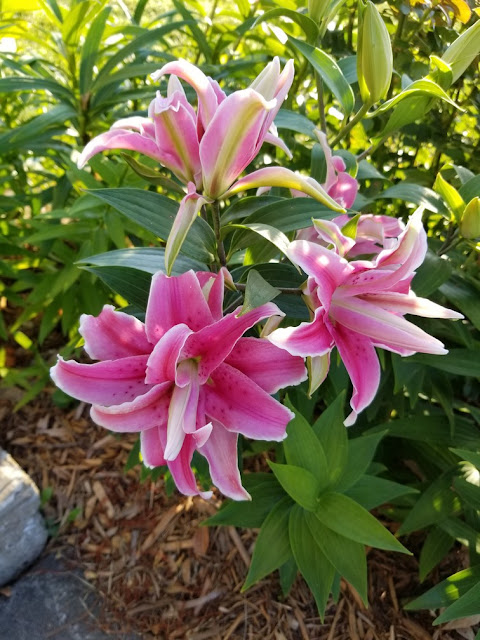This is payoff time for the vegetable garden. Cucumbers have been plentiful, and finally the weather has come down out of the 90s to some remarkably beautiful days in the low 80s with nights in the 60s. The tomatoes, therefore, are finally ripening.
'Missouri Pink Love Apple'
There are onions ready to be pulled.
All those things together make a very tasty salad when drizzled with Persian lime infused olive oil and cooconut infused white balsamic vinegar from a beautiful store in Columbia, Missouri. Boone Olive Oil Company has an amazing array of olive oils and infused vinegars - all of which you can taste for free. What more could you ask? Unless it's some of each, please.
There are carrots that can be harvested. I think I've said before this variety is 'Short 'n Sweet' and is short, for certain, but not particularly sweet. I don't eat a lot of raw carrots (an understatement), but I do freeze them for winter soups and one of my favorite things - carrot cake. Frozen carrots make the cake extra moist, compared to fresh carrots.
I'm excited for future years of blackberries and raspberries. This is the first year I'm able to harvest anything since they were only planted last fall, so there aren't many berries. But there's not much that can surpass berries picked right off the vine, and I'm thrilled with each one.
The 'Navaho' variety thornless blackberries start ripening with a shiny cherry red color.
From the photo above to the one below of ready to harvest berries was about five days.
A little breakfast treat sprinkled with processed and raw sugars:
I don't know what I'm going to do about the Japanese beetle issue on the raspberries. So far, I've broken down and sprayed them with Sevin, but that's not going to work when they have ripening berries, because I don't want to eat insecticide.
I guess I'm going to have to cover them like I do the rose buds, but the canes are long and sprawling with flower clusters all along the length, so it's going to take a lot of cover. Darned beetles. There has been a major reduction in numbers this year than the previous two, which I'm attributing to the length of time the ground was frozen this past winter, but those that are here are concentrating on my raspberries. That's totally unacceptable.
The French Charentais canteloupes are all producing fruit - some more prolifically than others. So far, there haven't been any pest problems with them. There's a small amount of powdery mildew on the shady side of one of the plants at ground level, but it's not enough to worry about. I'll just keep an eye on it.

Otherwise, the plants have grown to the tops of their cages, and these below I've let sprawl a little on the ground where I had nothing planted anyway.
'Petite Gris de Rennes' French charentais canteloupe
The 'Petite Gris de Rennes' are outperforming the 'Savor' that I liked so much last year. Already one of the 'Petite Gris' melons ripened. I try to keep the forming fruit pulled to the outside of the cages, but one had gotten trapped in the cage wire. I didn't see it there, so it got so ripe it split open. The flesh was still firm, not at all mushy, which was one of the things I was impressed with last year.
I also have some plants growing on my compost hill, and one very large, lopsided melon tempted me to pick it. I don't think it's really ripe yet, judging by the color, but I'm letting it finish indoors to see how much difference it makes to pick them early.
'Petit Gris de Rennes' melon and "Mrs. Maxwell's Big Italian' tomato
As for that tomato, so far, I'm still favoring the flavor of my standby 'Missouri Pink Love Apple' over the 'Mrs. Maxwell's' variety that I'm testing this year. They're both potato-leaf pink varieties.
The 'Henderson's Bush' lima beans are starting to form pods, but are mostly still in the flowering stage.
And, of course, I've been harvesting flowers for a while now. I love the color of these 'Queen Lime' orange zinnias. They'll be making an appearance in future years without question.
The Stargazer lilies are finished blooming, but the last of them made some gorgeous bouquets. These doubles that I have for the first time this year are perfectly set off by the carmine and lilac colors of the gomphrena (globe amaranth).
Double Stargazers, gomphrena, yarrow and celery
The doubles are a mutant form that have no anthers and stamens, only petals.
Too bad daylily blooms only last a day. These fabulous orange blooms go great with purple.
Daylilies, Lisianthus, Liatris, Yarrow, Mexican sunflower (Tithonia)
Blue and green Lisianthus (prairie gentian)
'Green Twister' Echinacea with yarrow in the background
























































